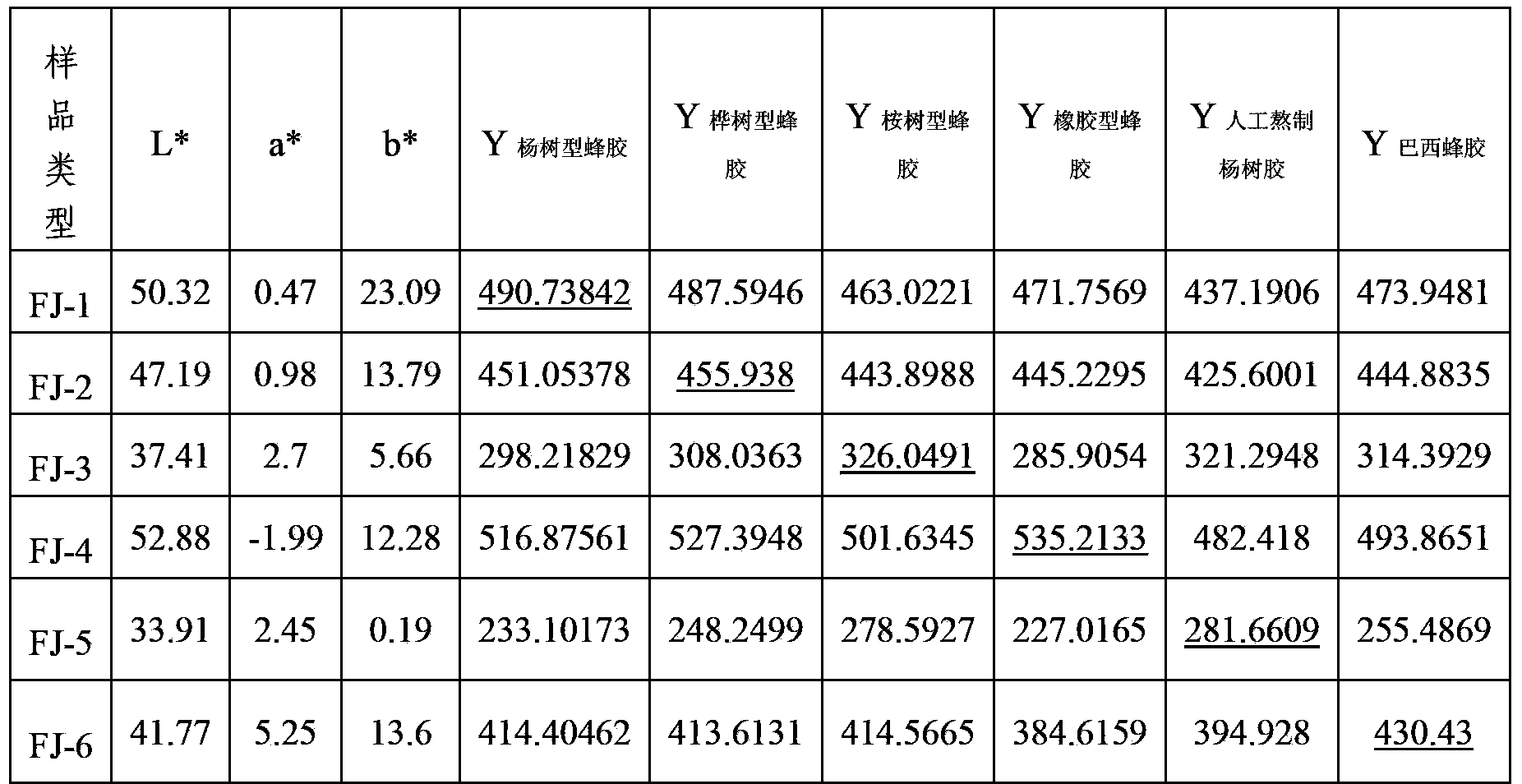Method for discriminating types of propolis raw materials
A technology for propolis and raw materials, which is applied in the measurement of color/spectral characteristics, etc., can solve the problems of cumbersome and time-consuming detection process, expensive detection cost, and expensive and precise instruments, and achieves a clear and definite judgment result, an easy judgment method and a high correct judgment rate. Effect
- Summary
- Abstract
- Description
- Claims
- Application Information
AI Technical Summary
Problems solved by technology
Method used
Image
Examples
Embodiment 1
[0036] Take six samples of propolis raw materials (coarse glue) whose glue source plants are poplar, birch, eucalyptus, rubber, Brazilian propolis, and artificially boiled poplar gum, place them in a -10°C refrigerator for 24 hours, and use a leather hammer After crushing, it is crushed in a 2000r / min high-speed pulverizer;
[0037] Accurately weigh 2.0g of each pulverized sample into a centrifuge tube, add 50ml of absolute ethanol, shake on a rotary shaker for 2 hours, ultrasonically extract for 1 hour, centrifuge at low temperature and high speed at 0°C and 10,000r / min for 10min, and use a pipette to remove the supernatant Transfer to a transparent disposable plastic petri dish (specification 9cm), and place a piece of white filter paper under the petri dish;
[0038] The L*a*b* values of propolis raw material alcohol solutions were measured with the help of a colorimeter, and the measured data values were substituted into the six glue source discrimination models of the...
Embodiment 2
[0049]The propolis sample is a domestic sample. It is known that its type is one of the above six types, but the specific type of glue source is unknown. The number is FJ-1. Grinding in a high-speed pulverizer, passing the crushed sample through a 20-mesh sieve; accurately weighing 2.0g into a centrifuge tube, adding 50mL of absolute ethanol, shaking on a rotary shaker for 2h, ultrasonic extraction for 1h, and low temperature at 0°C and 10000r / min Centrifuge at high speed for 10 minutes, transfer the supernatant to a transparent disposable plastic petri dish (9cm in size) with a straw, and place a piece of white filter paper under the petri dish;
[0050] The L*, a*, and b* values of the FJ-1 alcohol solution were measured with the help of a colorimeter, and the measured data values were substituted into the linear discriminant model of the six types of propolis. The results are shown in Table 2.
[0051] Comparing the size of the 6 Y values, the maximum value is the calcu...
Embodiment 3
[0053] The known type of propolis is one of the above six types, but the specific source of propolis is unknown, numbered FJ-2, placed in a -10°C refrigerator for 5 hours, crushed with a hammer, and crushed at a high speed of 2000r / min Grinding in the machine, passing the crushed sample through a 20-mesh sieve; accurately weighing 2.0g into a centrifuge tube, adding 50mL of absolute ethanol, shaking on a rotary shaker for 2h, ultrasonically extracting for 1h, and centrifuging at low temperature and high speed for 10min at 0°C and 10,000r / min , transfer the supernatant to a transparent disposable plastic petri dish (specification 9cm) with a straw, and place a piece of white filter paper under the petri dish;
[0054] The L*, a*, and b* values of the propolis raw material alcohol solution were measured with the help of a colorimeter, and the measured data values were substituted into the discriminant model formulas (1) to (6) in Example 1 for calculation. The results are sho...
PUM
 Login to View More
Login to View More Abstract
Description
Claims
Application Information
 Login to View More
Login to View More - R&D
- Intellectual Property
- Life Sciences
- Materials
- Tech Scout
- Unparalleled Data Quality
- Higher Quality Content
- 60% Fewer Hallucinations
Browse by: Latest US Patents, China's latest patents, Technical Efficacy Thesaurus, Application Domain, Technology Topic, Popular Technical Reports.
© 2025 PatSnap. All rights reserved.Legal|Privacy policy|Modern Slavery Act Transparency Statement|Sitemap|About US| Contact US: help@patsnap.com

